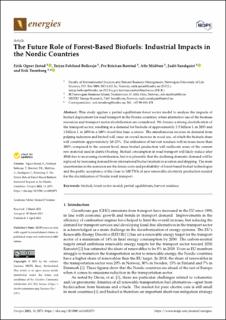| dc.contributor.author | Jåstad, Eirik Ogner | |
| dc.contributor.author | Bolkesjø, Torjus Folsland | |
| dc.contributor.author | Rørstad, Per Kr. | |
| dc.contributor.author | Midttun, Atle | |
| dc.contributor.author | Sandquist, Judit | |
| dc.contributor.author | Trømborg, Erik | |
| dc.date.accessioned | 2021-05-19T10:42:19Z | |
| dc.date.available | 2021-05-19T10:42:19Z | |
| dc.date.created | 2021-05-07T14:27:29Z | |
| dc.date.issued | 2021 | |
| dc.identifier.issn | 1996-1073 | |
| dc.identifier.uri | https://hdl.handle.net/11250/2755643 | |
| dc.description.abstract | This study applies a partial equilibrium forest sector model to analyse the impacts of biofuel deployment for road transport in the Nordic countries, when alternative use of the biomass resources and transport sector electrification are considered. We foresee a strong electrification of the transport sector, resulting in a demand for biofuels of approximately 2.5 billion L in 2035 and 1 billion L in 2050 in a 100% fossil-free base scenario. The simultaneous increase in demand from pulping industries and biofuel will cause an overall increase in wood use, of which the biofuels share will constitute approximately 20–25%. The utilization of harvest residues will increase more than 300% compared to the current level, since biofuel production will reallocate some of the current raw material used in district heating. Biofuel consumption in road transport will likely reduce after 2040 due to increasing electrification, but it is plausible that the declining domestic demand will be replaced by increasing demand from international biofuel markets in aviation and shipping. The main uncertainties in the scenarios are the future costs and profitability of forest-based biofuel technologies and the public acceptance of the close to 100 TWh of new renewable electricity production needed for the electrification of Nordic road transport | |
| dc.language.iso | eng | |
| dc.title | The Future Role of Forest-Based Biofuels: Industrial Impacts in the Nordic Countries | |
| dc.type | Peer reviewed | |
| dc.type | Journal article | |
| dc.description.version | publishedVersion | |
| dc.source.volume | 14 | |
| dc.source.journal | Energies | |
| dc.source.issue | 8 | |
| dc.identifier.doi | 10.3390/en14082073 | |
| dc.identifier.cristin | 1908797 | |
| dc.relation.project | Norges forskningsråd: 255265 | |
| dc.relation.project | Norges forskningsråd: 257622 | |
| cristin.ispublished | true | |
| cristin.fulltext | original | |
| cristin.qualitycode | 1 | |
